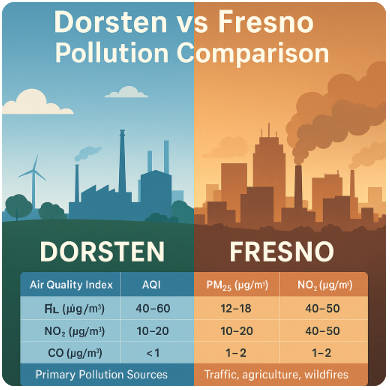Introduction
Pollution has become a central concern in urban planning and public health around the globe. This is especially true when comparing cities from different continents, like Dorsten in Germany and Fresno in California. While Dorsten is a modestly industrial town located in North Rhine-Westphalia, Fresno is a bustling agricultural hub in California’s Central Valley.
Both cities face pollution challenges, but the scale, sources, and consequences vary widely. This detailed comparison—referred to as the dorsten vs fresno pollution coparament—explores their environmental conditions in-depth.
Geographical and Environmental Context
Dorsten is situated on the edge of the Ruhr industrial area, which historically played a significant role in Germany’s coal and steel production. Though the region has undergone economic transformation, traces of industrial activity still impact the local environment.
On the other hand, Fresno lies in a valley enclosed by mountains, which unfortunately traps pollutants close to the surface. This geographic trait amplifies Fresno’s pollution levels, especially during summer and wildfire seasons.
In terms of natural ventilation, Dorsten benefits from frequent rain and flat terrain, which help disperse pollutants. Fresno’s dry and sunny climate, coupled with low wind movement in the valley, allows pollutants to accumulate over time.
Air Quality Overview
The Air Quality Index (AQI) is a universal metric used to measure air pollution levels. AQI includes various pollutants such as PM2.5, PM10, ozone, nitrogen dioxide, and carbon monoxide. The AQI scale ranges from 0 to 500, with higher values indicating worse air quality.
| City | Average AQI | Peak AQI | Common Pollutants |
|---|---|---|---|
| Dorsten | 40–60 | 80 | PM2.5, NO₂, O₃ |
| Fresno | 100–150 | 200+ | PM2.5, O₃, NO₂, CO, wildfire ash |
In Dorsten, AQI levels typically remain within the “Moderate” category. However, in Fresno, AQI often falls into the “Unhealthy for Sensitive Groups” range and can rise to “Very Unhealthy” or “Hazardous” during wildfire season. The dorsten vs fresno pollution coparament highlights this significant disparity.
Primary Sources of Pollution
The origins of pollution differ based on economic activities and regional policies. Dorsten’s pollution is primarily linked to:
- Residual industrial emissions
- Agricultural pesticide use
- Traffic congestion in urban areas
In contrast, Fresno’s pollution stems from:
- Intensive agriculture that releases dust and pesticides
- Vehicular traffic in a growing metropolitan area
- Wildfires that frequently affect the Central Valley
- Industrial operations like oil extraction and food processing
These different sources influence not only the volume but also the composition of pollutants found in the two cities.
Key Pollutants and Their Levels
Particulate Matter (PM2.5 & PM10)
Fine particulate matter is among the most dangerous pollutants due to its ability to penetrate deep into the lungs and bloodstream. In Dorsten, PM2.5 levels generally stay below the European threshold of 25 µg/m³. Fresno, however, frequently exceeds both US and World Health Organization (WHO) guidelines, with PM2.5 levels often surpassing 40 µg/m³.
Nitrogen Dioxide (NO₂)
NO₂ is commonly produced by traffic and industrial processes. Dorsten’s NO₂ levels range from 10 to 20 µg/m³, while Fresno’s levels are notably higher, often hitting 40 to 50 µg/m³ due to denser vehicle emissions and limited atmospheric dispersion.
Ozone (O₃)
Ozone is formed by chemical reactions between sunlight and pollutants. Fresno’s hot and sunny climate leads to higher ozone formation, making it one of the worst cities in the U.S. for ozone pollution. Dorsten, with its milder climate, does not face this issue as severely.
| Pollutant | Dorsten Avg (µg/m³) | Fresno Avg (µg/m³) |
|---|---|---|
| PM2.5 | 12–18 | 40–50 |
| NO₂ | 10–20 | 40–50 |
| O₃ | 20–40 | 60–100 |
Health Impacts
Pollution has a direct and often devastating impact on human health. In Dorsten, residents may experience mild respiratory issues and occasional allergies, mostly due to agricultural and seasonal factors. However, these effects are generally limited and less chronic.
In Fresno, health consequences are more severe and widespread. The city consistently ranks high in asthma-related emergency visits, particularly among children and the elderly. Prolonged exposure to high levels of PM2.5 and ozone increases the risk of:
- Asthma attacks
- Bronchitis and other respiratory issues
- Heart disease
- Lung cancer
- Premature death
This health-based aspect of the dorsten vs fresno pollution coparament underlines how air quality disparities directly translate to life-quality issues.
Water Pollution Concerns
While air pollution is often more visible, water contamination is equally serious. Dorsten’s water systems face challenges from:
- Agricultural runoff containing fertilizers and pesticides
- Industrial discharge affecting rivers and streams
Fresno’s groundwater is at higher risk. Due to heavy reliance on underground aquifers for drinking water, contamination from agricultural chemicals such as nitrates and arsenic has been a persistent problem.
| Type of Water Pollution | Dorsten | Fresno |
|---|---|---|
| Agricultural Runoff | Moderate | High |
| Industrial Discharge | Low to Moderate | Moderate to High |
| Groundwater Safety | Generally Safe | At risk (nitrates, arsenic, etc.) |
Regulatory Framework and Mitigation Efforts
The difference in pollution levels is partly due to the difference in environmental regulations. Dorsten, as part of the EU, follows strict emission control rules. These include the use of catalytic converters in vehicles, promotion of public transport, and regulations on industrial waste.
Fresno operates under both federal and state-level guidelines, particularly the California Air Resources Board (CARB), which enforces aggressive emission reduction measures. Despite this, Fresno struggles due to:
- Its geographical disadvantage
- Growing population
- Agricultural and wildfire issues that are hard to control
Both cities are making efforts, but Dorsten’s environmental success is partly due to policies backed by favorable geography.
Community Initiatives and Public Awareness
Public engagement plays a vital role in pollution control. Dorsten has launched several community-driven sustainability programs, including:
- Tree-planting drives
- Public transport incentives
- Recycling and composting education
In Fresno, the situation is improving through:
- School-based awareness programs
- Government-funded air quality alert systems
- Water conservation campaigns
Though Fresno faces more significant environmental challenges, local activism and awareness are gradually pushing for positive change.
Conclusion
The dorsten vs fresno pollution coparament presents a tale of two cities—each dealing with pollution but on very different scales and with varying outcomes. Dorsten, aided by strict European policies and favorable geography, maintains relatively clean air and water. Fresno, while progressive in its regulation, battles serious environmental issues rooted in its location and economic structure.
Related Articles
FintechZoom.com Gold: The Ultimate Guide to Smart Gold Investment in 2025
Crypto30x.com Ocean: A Complete Guide to the High-Leverage Crypto Platform
What is .ydesi? Complete Guide to the New Cultural Domain for the South Asian Community
InfluncersGoneWild: The Shocking Rise, Impact, and Ethics of Social Media Extremes

